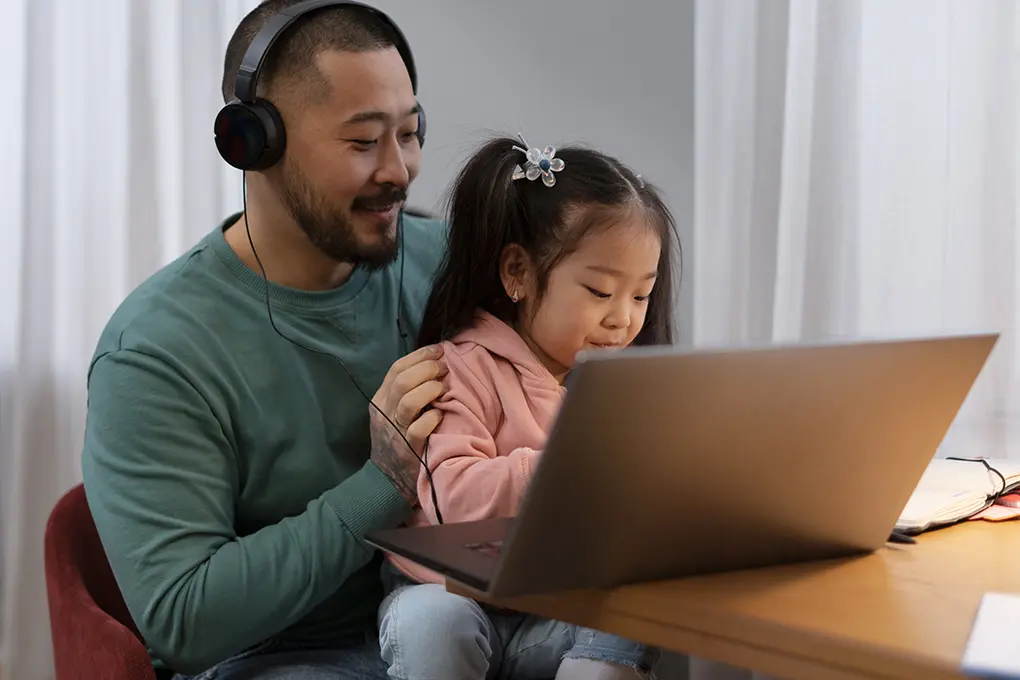A recent study found that children as young as eight years old typically have their first social media accounts despite most platforms setting 13 as the minimum age requirement. For parents, this raises an urgent challenge: how do we prepare our children to navigate the online world safely while respecting their growing independence?
At Batten Cyber, we’ve helped thousands of families protect not just their physical homes but also their online lives.
One consistent theme we’ve observed is that the most successful safety approach combines the right tools with open, age-appropriate conversations, just one of the factors we’ll discuss today. Technology alone can’t replace the guidance and wisdom that come from a parent who is willing to talk honestly about online risks and responsible behavior.
Keep reading to find out everything there is to know about how to talk to kids about online safety and teaching children cybersecurity.
Contents
- Key Takeaways
- Why Conversations About Online Safety Matter
- Starting the Conversation: Age-Appropriate Approaches
- Creating a Family Media Agreement
- Balancing Monitoring and Trust
- What to Do When Problems Arise
- Utilizing Technology as a Parenting Partner
- Staying Current
- Conclusion: Building Digital Resilience for Life
- Frequently Asked Questions
Key Takeaways
- Start online safety conversations early and tailor them by age.
- Young kids benefit from simple rules and visual reminders.
- Pre-teens need guidance on privacy, data use, and digital boundaries.
- Teens respond best to respectful, real-world discussions on risks.
- A family media agreement helps create shared expectations.
- Balance supervision with trust as your child matures.
- Use technology to support, not replace, open conversations.
Why Conversations About Online Safety Matter
The online world your children experience today bears little resemblance to the internet of even five years ago. Artificial intelligence, social media algorithms, and data collection practices have transformed how information is shared, stored, and potentially misused. As technology has developed, so have new threats grown.
For some perspective, as many as 12 million children in the USA face cyber threats each year. Also, consider that in recent years, as many as 1.7 million children in America suffered from data breaches and leaked personal information, something you certainly don’t want happening to your kids.
Even more alarming, up to 32% of teen girls report facing online harassment, often sexual, and that number is 24% for teen boys. This illustrates the importance of keeping your children’s information private. Having a children’s internet privacy conversation is crucial.
When parents establish regular conversations about internet safety, several important things happen:
- Children learn to recognize potential dangers before encountering them
- They develop critical thinking skills to question what they see online
- They’re more likely to come to you when they encounter something concerning
- They understand the permanence of their digital footprint
- They build a foundation for responsible digital citizenship
The goal isn’t to frighten children but to empower them with knowledge and judgment. Many parents we work with express concern about striking this balance, being protective without being overprotective, and informative without causing anxiety.
Starting the Conversation: Age-Appropriate Approaches
In terms of teaching kids cybersecurity, how you have this conversation and what you teach really depends on their age. Let’s figure out how to talk to kids about online safety based on their age group
1. For Young Children (Ages 5 to 8)
Young children are just beginning to explore digital devices, often through games, educational apps, or watching videos. At this stage, conversations should be simple, concrete, and focused on basic safety concepts.
For children this age, the internet is an abstract concept. We’ve found that using relatable analogies works well.
For example, comparing online strangers to people they might meet at a playground helps establish boundaries they can understand. Just as they wouldn’t share personal information with someone they don’t know at the park, the same rule applies online.
Focus on establishing a few simple rules that are easy to remember:
- Always ask a grown-up before using a new app or website
- Never share your real name, address, or school with people online
- If you see something scary or confusing, tell a parent right away
- Be kind online, just like you would be in person
Young children respond well to visual aids. Consider creating a colorful poster of internet safety rules to hang near the computer or tablet they use. This serves as a constant, gentle reminder of the boundaries you’ve established together.
2. For Pre-Teens (Ages 9 to 12)
Pre-teens are typically becoming more independent online users, often getting their first smartphones and showing interest in social media and messaging apps. This is a crucial time to deepen conversations about privacy, digital footprints, and online reputation.
Consider that up to 10% of tweens experience predatory behavior when online, making these conversations just that much more important.
Many of the families we work with find that pre-teens are particularly receptive to discussions about privacy when framed in terms of their growing independence. You might explain that privacy is a form of personal power, the ability to control who knows what about you, and that giving away too much information online weakens that power.
When discussing social media and games with pre-teens, consider these conversation starters:
- “Let’s look at the privacy settings on this app together. What information do you think is OK to share, and what should stay private?”
- “Did you know that photos and messages you share online might stay there forever, even if you delete them later? Let’s talk about what that means.”
- “What would you do if someone you don’t know tries to chat with you in a game or sends you a friend request?”
Pre-teens often appreciate being treated as capable decision-makers. Instead of simply setting rules, try asking questions that help them think critically: “Why do you think this game is free? How might the company be making money?” This is also a good time to start teaching your kids how to recognize online scam sites and apps.
3. For Teenagers (Ages 13 to 17)
Teenagers value their privacy and independence, making conversations about online safety particularly delicate. The approach that works best with teens is one that respects their autonomy while acknowledging the very real risks they face.
Teens are likely already managing their own digital lives across multiple platforms. Many parents we’ve worked with find success by positioning themselves as allies rather than monitors. This means acknowledging that while teens have the right to privacy, they also need tools to recognize and respond to concerning situations.
Effective conversations with teenagers often center around these key topics:
Digital Reputation and Future Impact
The concept of a permanent digital footprint becomes particularly relevant as teens approach college applications and job searches.
Discuss how colleges and employers routinely check social media profiles, and how posts from earlier years can affect opportunities later in life.
Peer Pressure and Online Behavior
Social media can amplify peer pressure, leading teens to share more than they’re comfortable with or participate in risky challenges.
Discussing these pressures openly gives teens permission to use parents as a convenient excuse when they want to opt out: “My parents check my social media” can be a face-saving way to resist peer pressure.
Data Privacy and Personal Information
Teenagers are developing their consumer habits and may not realize how their data is collected and used.
Explain how “free” services make money by selling user data, and discuss what information is worth protecting. This is also a good time to discuss strong password practices and the risks of public WiFi. It’s always a good idea to have kids use strong password managers as well.
One approach that resonates with many teens is discussing real-world cases where privacy breaches or poor online choices had significant consequences. News stories about data breaches or viral incidents can provide natural openings for these conversations.
Creating a Family Media Agreement

After having age-appropriate conversations, consider formalizing your family’s approach to online safety with a family media agreement. This isn’t about imposing restrictions but creating shared expectations that everyone understands and has contributed to developing.
A good family media agreement typically covers the following:
- Where and when devices can be used (e.g., not during family meals or after bedtime)
- What personal information can be shared online and what should remain private
- How family members will respect each other’s digital boundaries
- Consequences for breaking agreed-upon rules
- A commitment to revisit and revise the agreement as children grow
The most effective agreements we’ve seen are those created collaboratively, with input from children of all ages. When kids participate in setting the rules, they’re more likely to understand and respect them. To learn more, read our article on creating a family cybersecurity plan.
Balancing Monitoring and Trust
One of the most challenging aspects of digital parenting is finding the right balance between monitoring children’s online activities and respecting their growing need for privacy. This looks different for every family and evolves as children mature.
For younger children, close supervision and filtering tools make sense. As they demonstrate responsible behavior, gradually increasing privacy and independence teaches them to self-regulate.
Many of the tools available through Batten’s child internet safety collection are designed to grow with your family, providing appropriate levels of monitoring for different ages and stages.
Some parents find success with a transparency approach: letting children know that while they respect their privacy, they will periodically review online activities to ensure safety. This isn’t about “catching” kids doing something wrong but maintaining an awareness of their digital experiences.
What to Do When Problems Arise
Despite the best preparations, children may still encounter troubling content or situations online. How parents respond in these moments has a profound impact on whether children will continue to share their digital experiences.
If your child reports an uncomfortable online interaction or exposure to inappropriate content:
- Stay calm and thank them for telling you
- Listen without judgment or blame
- Ask open-ended questions to understand what happened
- Explain why the situation is concerning
- Decide together on next steps
Your measured response teaches children that they can come to you with problems without fear of punishment or having their devices taken away. This open-door policy is one of the most powerful protections you can provide.
Utilizing Technology as a Parenting Partner
While conversations form the foundation of digital safety, technology can provide valuable support. The right tools can help enforce boundaries, monitor for concerning activities, and provide visibility into children’s online experiences.
Based on our experience with families across different age groups, we recommend a layered approach to digital protection:
- For Younger Children: Content filters and time management tools that prevent access to inappropriate material
- For Pre-Teens: Monitoring solutions that flag concerning interactions while respecting growing independence
- For Teenagers: Privacy-respecting tools that focus on extreme risks rather than day-to-day activities
Solutions like Aura’s family monitoring tool can provide that extra layer of security while still encouraging open conversations about online safety. These tools work best when implemented alongside, not instead of, regular family discussions about digital citizenship.
Staying Current
The internet evolves rapidly, with new platforms, risks, and opportunities emerging constantly. Staying informed about these changes helps parents maintain relevant conversations with their children.
Many of the parents we advise set aside time quarterly to:
- Research new apps or platforms their children are using
- Review and update privacy settings on existing accounts
- Discuss any new online trends or challenges they’ve heard about
- Revisit and revise family media agreements as needed
Organizations like Common Sense Media provide regularly updated resources on popular apps and platforms, helping parents understand the features, risks, and appropriate ages for various digital tools. Something else to keep in mind is that you can always use parental controls to monitor the online activities of your kids.
Conclusion: Building Digital Resilience for Life
The ultimate goal of conversations about online safety isn’t just to protect children now but to build skills they’ll carry throughout life. Digital resilience; the ability to recognize risks, make wise choices, and recover from negative experiences; serves children well beyond their years under your roof.
By combining open conversations, appropriate boundaries, and supportive technology, you’re preparing your children to navigate not just today’s digital landscape but tomorrow’s as well. The digital world will continue to evolve, but the principles of critical thinking, privacy awareness, and responsible behavior remain constant foundations.
Want to strengthen your family’s digital safety measures? Browse Batten’s expert-recommended cybersecurity and online safety tools designed specifically for families like yours.
Frequently Asked Questions
How Often Should I Talk to My Child About Online Safety?
Aim for check-ins every few months or whenever new apps, devices, or concerns come up. Keep the tone casual and open.
What If My Teen Doesn’t Want to Talk About Online Safety?
Start by asking their opinion on digital trends or news stories. Respect their independence while reinforcing your role as a trusted resource.
Should I Use Monitoring Tools Without Telling My Kids?
Transparency builds trust. Let them know what tools you use and why; it encourages honesty and collaboration.
What Are Signs My Child May Be Facing Online Harassment?
Watch for sudden mood changes, secrecy about devices, or withdrawal from activities. Ask open questions and create a safe space to talk.
How Can I Teach My Child to Spot Scam Websites or Apps?
Show them how to look for secure URLs, verify app developers, and use trusted sources. Practice together and explain how to check credibility.
Sources
- KIDS AS YOUNG AS 8 ARE USING SOCIAL MEDIA MORE THAN EVER, STUDY FINDS | PARENTING – MAG THE WEEKLY
- Kids and Cybersecurity statistics – Surfshark
- Protecting Our Kids’ Data Privacy is Paramount – National Cybersecurity Alliance
- Enough Is Enough: Internet Safety
- What Does It Mean For Social Media Platforms To “Sell” Our Data?
- Top Cybersecurity Threats [2025]
- Teens and Cyberbullying 2022 | Pew Research Center




